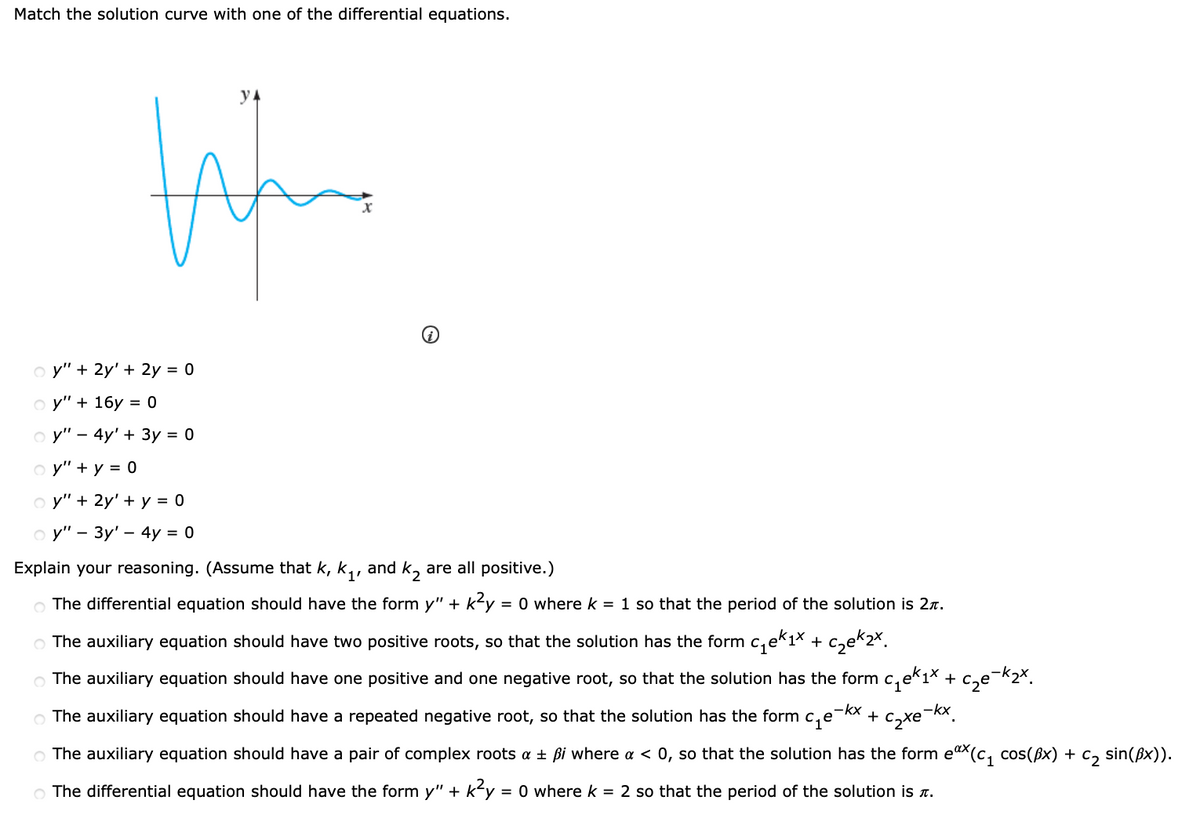o y" + 2y' + 2y = 0 y" + 16y = 0 o y" - 4y' + 3y = 0 y" + y = 0 y" + 2y' + y = 0 у" - Зу' — 4у 3 о Explain your reasoning. (Assume that k, k,, and k, are all positive.) The differential equation should have the form y" + k²y = 0 where k = 1 so that the period of the solution is 27. O The auxiliary equation should have two positive roots, so that the solution has the form c, ek1* + The auxiliary equation should have one positive and one negative root, so that the solution has the form c,e*1* + The auxiliary equation should have a repeated negative root, so that the solution has the form c,e + c,xe-kx. O The auxiliary equation should have a pair of complex roots a ± ßi where a < 0, so that the solution has the form ea(c, cos(ßx) + c, sin(ßx)). The differential equation should have the form y" + k
o y" + 2y' + 2y = 0 y" + 16y = 0 o y" - 4y' + 3y = 0 y" + y = 0 y" + 2y' + y = 0 у" - Зу' — 4у 3 о Explain your reasoning. (Assume that k, k,, and k, are all positive.) The differential equation should have the form y" + k²y = 0 where k = 1 so that the period of the solution is 27. O The auxiliary equation should have two positive roots, so that the solution has the form c, ek1* + The auxiliary equation should have one positive and one negative root, so that the solution has the form c,e*1* + The auxiliary equation should have a repeated negative root, so that the solution has the form c,e + c,xe-kx. O The auxiliary equation should have a pair of complex roots a ± ßi where a < 0, so that the solution has the form ea(c, cos(ßx) + c, sin(ßx)). The differential equation should have the form y" + k
Calculus: Early Transcendentals
8th Edition
ISBN:9781285741550
Author:James Stewart
Publisher:James Stewart
Chapter1: Functions And Models
Section: Chapter Questions
Problem 1RCC: (a) What is a function? What are its domain and range? (b) What is the graph of a function? (c) How...
Related questions
Question

Transcribed Image Text:Match the solution curve with one of the differential equations.
y 4
оу"+ 2y' + 2у %3D0
o y" + 16y = 0
o y" – 4y' + 3y = 0
o y" + y = 0
o y" + 2y' + y = 0
оу" - Зу' — 4y %3D0
Explain your reasoning. (Assume that k, k,, and k, are all positive.)
The differential equation should have the form y" + k<y = 0 where k = 1 so that the period of the solution is 27.
The auxiliary equation should have two positive roots, so that the solution has the form c, K1X + c,e*2X.
The auxiliary equation should have one positive and one negative root, so that the solution has the form c, ek1* + c,e-k2x.
O The auxiliary equation should have a repeated negative root, so that the solution has the form c,e
-kx
+ czxe-kx,
O The auxiliary equation should have a pair of complex roots a + ßi where a < 0, so that the solution has the form eax(c, cos(ßx) + c, sin(ßx)).
O The differential equation should have the form y" + k²y = 0 where k = 2 so that the period of the solution is T.
Expert Solution
This question has been solved!
Explore an expertly crafted, step-by-step solution for a thorough understanding of key concepts.
Step by step
Solved in 2 steps with 3 images

Recommended textbooks for you

Calculus: Early Transcendentals
Calculus
ISBN:
9781285741550
Author:
James Stewart
Publisher:
Cengage Learning

Thomas' Calculus (14th Edition)
Calculus
ISBN:
9780134438986
Author:
Joel R. Hass, Christopher E. Heil, Maurice D. Weir
Publisher:
PEARSON

Calculus: Early Transcendentals (3rd Edition)
Calculus
ISBN:
9780134763644
Author:
William L. Briggs, Lyle Cochran, Bernard Gillett, Eric Schulz
Publisher:
PEARSON

Calculus: Early Transcendentals
Calculus
ISBN:
9781285741550
Author:
James Stewart
Publisher:
Cengage Learning

Thomas' Calculus (14th Edition)
Calculus
ISBN:
9780134438986
Author:
Joel R. Hass, Christopher E. Heil, Maurice D. Weir
Publisher:
PEARSON

Calculus: Early Transcendentals (3rd Edition)
Calculus
ISBN:
9780134763644
Author:
William L. Briggs, Lyle Cochran, Bernard Gillett, Eric Schulz
Publisher:
PEARSON

Calculus: Early Transcendentals
Calculus
ISBN:
9781319050740
Author:
Jon Rogawski, Colin Adams, Robert Franzosa
Publisher:
W. H. Freeman


Calculus: Early Transcendental Functions
Calculus
ISBN:
9781337552516
Author:
Ron Larson, Bruce H. Edwards
Publisher:
Cengage Learning